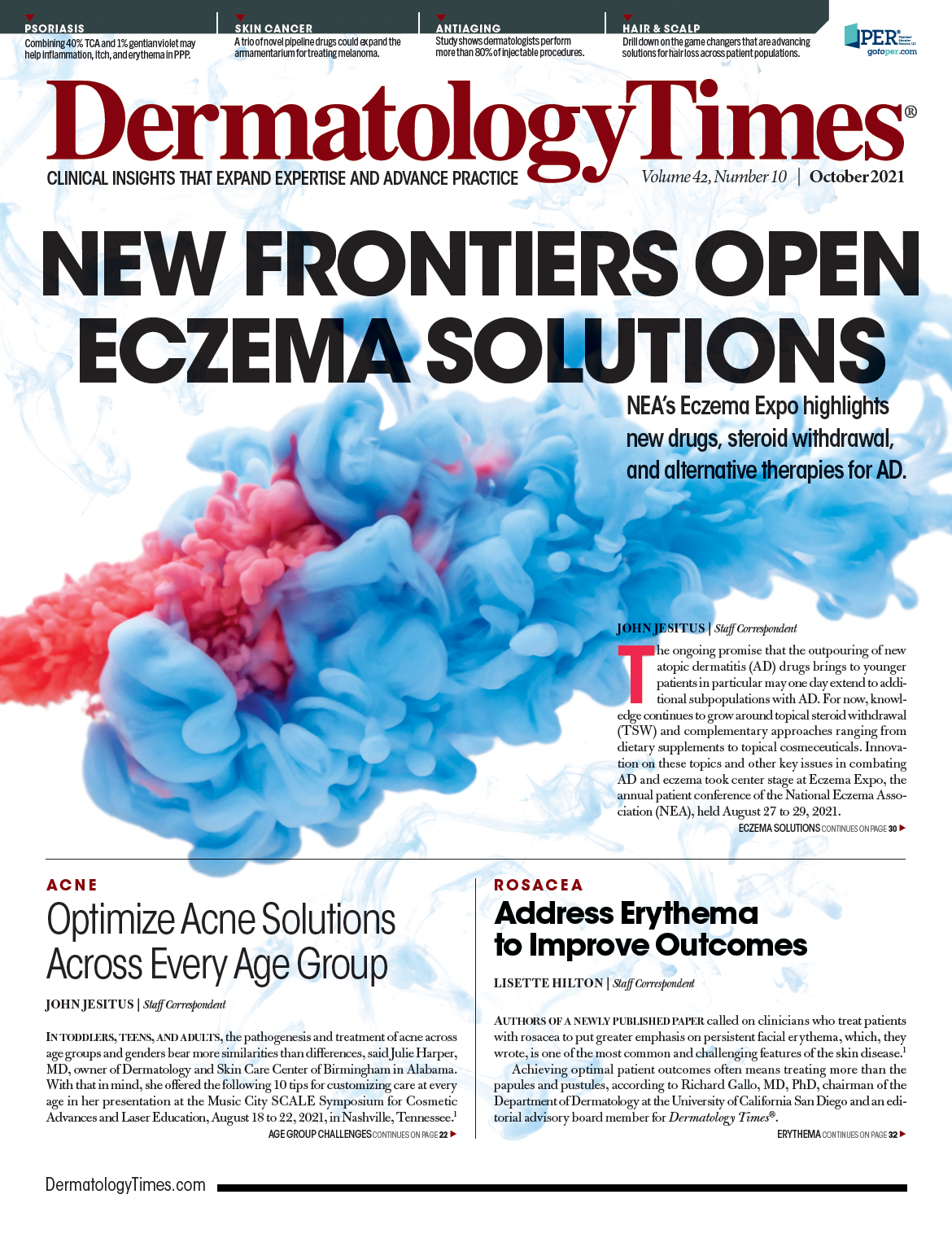- Case-Based Roundtable
- General Dermatology
- Eczema
- Chronic Hand Eczema
- Alopecia
- Aesthetics
- Vitiligo
- COVID-19
- Actinic Keratosis
- Precision Medicine and Biologics
- Rare Disease
- Wound Care
- Rosacea
- Psoriasis
- Psoriatic Arthritis
- Atopic Dermatitis
- Melasma
- NP and PA
- Skin Cancer
- Hidradenitis Suppurativa
- Drug Watch
- Pigmentary Disorders
- Acne
- Pediatric Dermatology
- Practice Management
- Prurigo Nodularis
- Buy-and-Bill
Publication
Article
Dermatology Times
Connecting Skin Diseases and COVID-19
Author(s):
Patients with skin conditions may be more likely to contract the disease but less likely to become severely ill.
Patients with skin diseases appear to be at increased risk for COVID-19 but at decreased risk for requiring mechanical ventilation if they acquire the infection, according to results from a recently published genetic epidemiology study.1
Findings from additional genomic studies conducted by the same investigators provide a starting point for future research to understand risk factors for infection and its course.
Matthew Patrick, MEng, PhD, a research investigator in the Department of Dermatology at the University of Michigan, Ann Arbor, is lead author of the published paper, which was guided and supported by senior author Lam C. Tsoi, PhD, assistant professor of dermatology and computational medicine and bioinformatics at the University of Michigan, Ann Arbor.
Patrick told Dermatology Times® that his interest in studying associations between COVID-19 and skin conditions was initially stimulated by reports describing skin manifestations accompanied by lymphocytic infiltration in COVID-19 patients. At that time, there was little known about whether having any skin conditions affected susceptibility to COVID-19. However, medical comorbidities that are common in patients with various inflammatory skin diseases, including diabetes, chronic kidney disease, and cardiovascular disease, were recognized as risk factors for COVID-19, and there were reports that certain respiratory tract and systemic infections occur more often among patients with inflammatory skin diseases.
“The results of our study have no immediate clinical implications and they need to be replicated in other genetic and epidemiological studies,” Patrick said. “However, they have raised some interesting ideas about pathophysiologic mechanisms for COVID-19 risk and severity that could be further explored in animal models.”
The epidemiology of COVID-19 among patients with inflammatory skin diseases was investigated using the Michigan Medicine database to identify individuals who had an encounter with the health system between January 1, 2019, and June 20, 2020.Data on race, age, sex, body mass index, socioeconomic status, and 24 disease conditions representing both systemic and skin diagnoses were extracted.
The risks of COVID-19 and need for mechanical ventilation for COVID-19 supportive care were determined using logistic regression with correcting for multiple testing, conditioning on all covariates, and applying each of the comorbidities by itself. The analyses included data for 435,019 patients, of whom 1,115 (0.26%) had COVID-19. Within the latter cohort, 150 patients (13.5%) required mechanical ventilation.
A statistically significant increased risk of COVID-19 of about 50% was found for each of the following skin conditions: acne, burn injury, psoriasis, and atopic dermatitis. In addition, cutaneous lupus was associated with a nominally significant increased risk of COVID-19 (67%; P = .038). When all patients with any inflammatory skin disease were considered together, they had a 59% significantly increased risk of COVID-19, and there was a 55% significantly increased risk for the cohort of patients with any skin disease.
No significant associations were found between treatment with any of 31 immunosuppressant agents and COVID-19 risk, although a relationship between IL-17–targeted biologics and increased risk for COVID-19 was close to nominal significance. Additional analyses corroborated previous reports showing an increased risk for COVID-19 in individuals with chronic kidney disease, diabetes, coronary artery disease, chronic obstructive pulmonary disease, asthma, and hypertension.
The analyses of risk for requiring mechanical ventilation among patients with COVID-19 found that having a skin condition had a greater impact than any other of the tested comorbidities, although in contrast to all other significant comorbidities, the effect of having a skin condition was to reduce the risk. For patients with any skin condition, the risk of requiring mechanical ventilation was decreased 78% while the subgroup of patients with an inflammatory skin disease were 84% less likely to need mechanical ventilation. No significant associations were found between mortality and having a skin condition or inflammatory skin disease, but there were few deaths among patients with COVID-19 and a skin condition. Therefore, Patrick and colleagues pointed out that the study may have been underpowered to detect statistical significance.
Genomic Studies
Shared mechanisms between skin conditions and COVID-19 infection were explored by comparing transcriptomic expression data from 9 skin conditions and from bronchial epithelial cell lines infected with the causative virus for COVID-19. Genes showing increased expression in both the skin conditions and in the infected bronchial cells included those involved in epidermal differentiation and in the IL-17 signaling pathway that is involved in inflammatory responses. Comparisons of data from a previous study of genetics in a sample including over 11,000 patients with data from the COVID-19 Host Genetics Initiative2 meta-analysis also identified a shared genome-wide significant locus in the epidermal differentiation complex.
Fitting the Pieces Together
Applying the findings from the genomic study to the associations that were identified between COVID-19 risk and skin diseases in the epidemiological study, the researchers postulated that a defective epidermal barrier in the setting of certain skin conditions may enable entry of the SARS-CoV-2 virus through the respiratory epithelium or allow for a reservoir of virus to develop in the skin. At the same time, however, these patients’ characteristic immune response would limit the severity of COVID-19.
References:
- Patrick MT, Zhang H, Wasikowski R, et al. Associations between COVID-19 and skin conditions identified through epidemiology and genomic studies. J Allergy Clin Immunol. 2021;147(3):857-869. doi:10.1016/j.jaci.2021.01.006
- The COVID-19 host genetics initiative. COVID-19 hg. Accessed September 1, 2021. https://www.covid19hg.org/







